Monthly Archives: May 2014
It’s time.
- On: May 21, 2014
 0
0
It’s time to start eating fresh food again! Our CSA deliveries begin this week for weekly members and for green every-other-week (EOW) members. Purple EOW, your first delivery is next week.
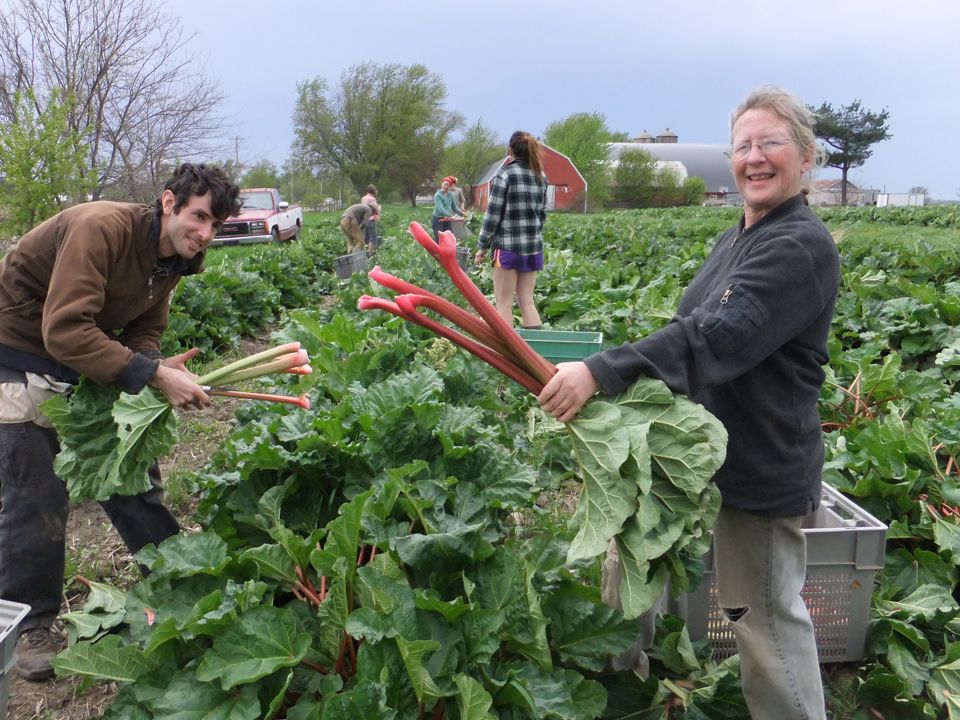
Simone, Jon and others harvest rhubarb.
Things you need to know.
♦ We post this newsletter/blog online each Wednesday night, with the list of veggies for the week, the quantities, information about storage and preparation, plus news of the farm. We’ll send an email on Wednesday night to alert you once the newsletter is ready to read.
♦ EOW and weekly members, we assume that you read all the newsletters, even on your “off” weeks. The newsletter (and our emails to you) are our means to communicate with you.
♦ The first few boxes of the season are always the lightest. EOW members, please do not worry that you have signed up for the wrong share. Our deliveries get heavier and more abundant as the season progresses.
♦ Pat Mulvey of Local Thyme will prepare menus and recipes for us again this year, but you have to register on her website for access. It’s free for Tipi CSA members. Go to www.localthyme.net/register and enter the access code that I sent in my May 2 email. If you need the code or instructions again, send me an email titled “LT please.”
Farm News
Most of our spring work involves planting for future harvests. It feels novel to harvest something!
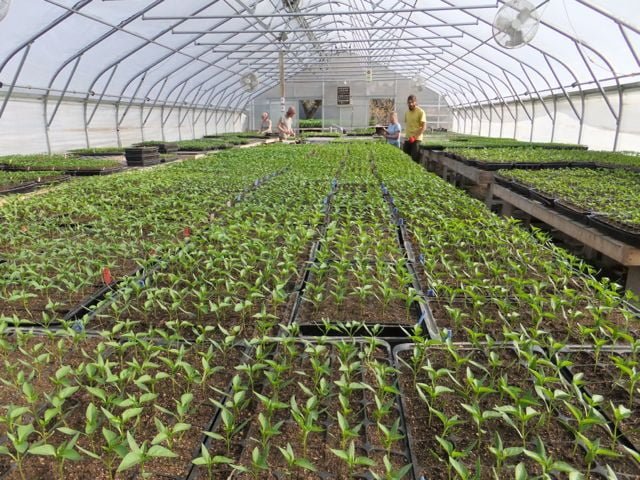
There’s always a moment when we ask ourselves if we’ve planted too many peppers. The answer is “No, you cannot have too many peppers.” The seedlings in the photo above are from our second pepper seeding. These will be large enough to transplant to the field next week.
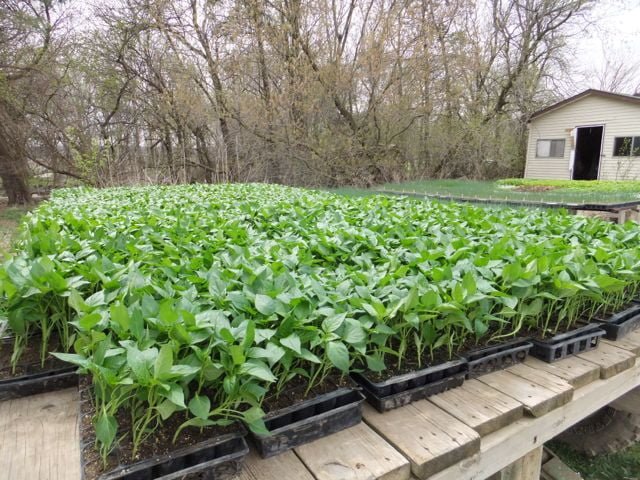
This is the first pepper planting. These babies are already out in the field and growing.
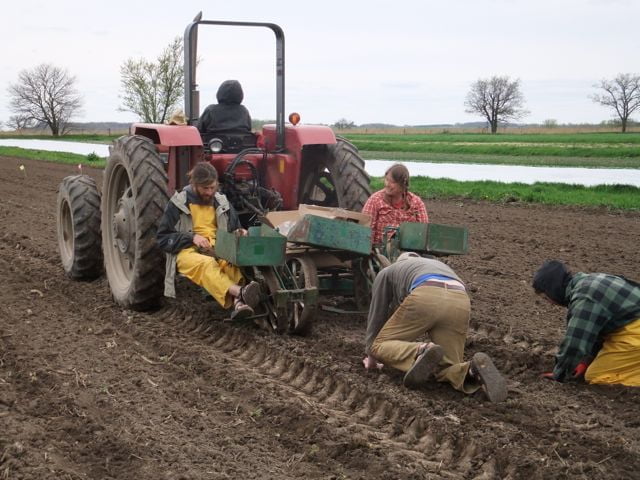
We planted next year’s strawberry field before this year’s crop even flowered. Above, Clint and Maggie ride the strawberry transplanter. Simone drives, Michael and Bonnie settle the plants.
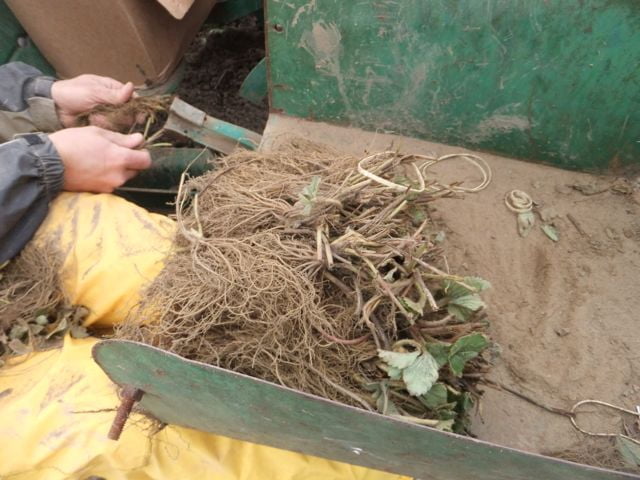
The new berry plants come to us with their tops sheared to lessen transplant shock. They perk up and start growing within a few days.
Veggie Notes (week #1, green EOW members).
We list the week’s veggies and quantities in this section, as well as information about individual vegetables. We’ll share our list of expected vegetables for the following week. I provide extra info on cooking and storage the first week that we send a vegetable. Does an item need extra washing? Does it have special qualities? This is the place to find out. For example, please, please refrigerate the potatoes. We explain the reason below.
Asparagus, 1.8 lb
Spinach, 1 to 1.25 lb
Green leaf lettuce
Arugula, one tender bunch
Salad radishes, one bunch
Goldrush russet potatoes, 3.5 lb
Rhubarb, 2 lb
Next week’s box will probably contain asparagus, spinach, lettuce, arugula, radishes, button mushrooms, bok choy and rhubarb. Maybe green garlic too.
Asparagus – Enjoy this spring treat! You will receive asparagus in a paper bag, including a small bundle tied with a rubber band. Use the rubber-banded asparagus first because it is older. Your asparagus will be green or purple. The purple variety turns dark green when cooked. Its flavor is almost identical to normal green asparagus. You must wash this asparagus thoroughly to remove hidden grit. Submerge it in water, soak briefly, then swish vigorously and pull out of the water with the tips pointing down. The draining action helps pull the grit out of the asparagus tips. Repeat several times.
Storage: Asparagus is perishable, so eat it as soon as possible. To store it, wrap the bundle in paper or cloth and store it loosely in a plastic bag. The asparagus tips tend to rot if in direct contact with the plastic bag. We snap our asparagus at harvest, rather than cutting it. Therefore, there is no need to snap the stalks to remove fibrous ends. For the same reason, it is not necessary to peel the asparagus stalks. It’s OK to trim the end a bit.
Cooking: If your asparagus stalks vary greatly in size, you will want to cook the thicker ones longer. Put the asparagus in a steamer pot over water. Alternatively, you can lay spears flat in the bottom of a broad pan, with ½ inch of water. Cover and steam over medium heat until just tender. Use two forks or a spatula to turn the asparagus during cooking, rotating the bottom spears to the top. Drain and serve. Also excellent broiled or grilled. Good dressed with vinaigrette, or simply with lime juice, salt and pepper.
Rhubarb – Refrigerate in a plastic bag. FYI, 2 lb of rhubarb yields about 6 to 6.5 cups when chopped.
Stewed rhubarb: This is the simplest way to prepare rhubarb. Chop rhubarb into one inch chunks. Stir over medium heat with a small amount of water in the bottom of the pan. The rhubarb will release moisture as it cooks. Stew until it softens and falls apart. Sweeten to taste with honey or sugar. Eat warm on its own, over vanilla ice cream, on pancakes, etc.
Goldrush russet potatoes – Please refrigerate these potatoes. They are in great shape now but will sprout within days if stored at room temperature. They’ve been stored all winter and want to grow. Store in a paper bag to protect from light, even in the fridge. We grow everything we send in our CSA boxes except potatoes, garlic and mushrooms, which we buy from organic growers that we trust. We purchased these potatoes from Jesse Perkins at Vermont Valley Farm. Jesse says the potatoes have a higher sugar content because of starch to sugar conversion during cold storage. The potatoes taste a bit sweet, and will blacken slightly when fried. It’s a harmless color change due to the sugar conversion.
Arugula – (small bunch of green leaves with pungent scent) – Arugula is good mixed with lettuce or spinach in salads, or added to cooked dishes such as lasagne or quiche. I love it on sandwiches. This arugula is thin-leaved and tender and will not store for long. Eat soon. It wilted a bit while we were harvesting it. That’s what happens when you keep it sheltered under row cover (to protect from insects), then pull off the row cover to harvest on a windy day. Cover and refrigerate.



